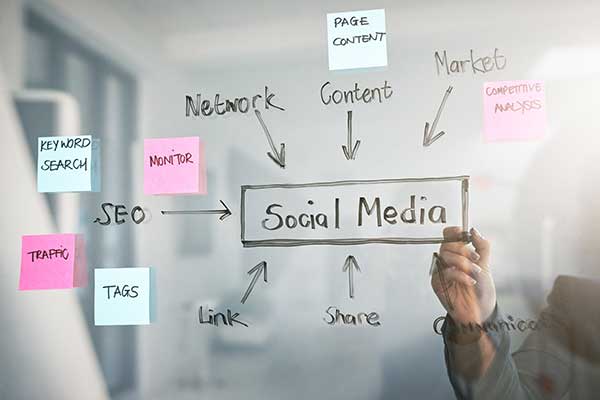B2B manufacturers can drive product demand through influencer marketing’s ability to engage with highly relevant audiences.

By Amanda Haley, Lead Product Consultant for ECI Software Solutions
Influencer marketing has become an important part of businesses’ promotional strategy and is poised to generate more than $11 billion through the end of 2022 alone. Nielsen data shows that influencer marketing is among the tools that businesses can use to increase brand recall by more than 70%. And according to a report by Influencer Marketing Hub, businesses earn an average of nearly $6 (and as much as $18) in promotional publicity for every $1 spent on influencer marketing. That report also reveals that Google searches for “influencer marketing” have increased by more than 460% since 2016, and that almost all survey respondents (90%) feel that influencer marketing is effective.
While the growth of influencer marketing is clear, some businesses may not realize the power and potential it provides to B2B marketing. Manufacturers, for example, can use this largely untapped vehicle to get in front of more relevant buyers. This is more than getting in on a trend – influencer marketing has the ability to make direct connections with relevant audiences while bringing on-the-ground credibility to the products you’re distributing. It allows manufacturers to put a more personal face on their brand, empowering audiences to gain a behind-the-curtain view of the company’s process. Better still, influencer marketing gives manufacturers the opportunity to tie their brand to industry trends that are driving visibility across the supply chain.
Before beginning any influencer marketing campaign, it’s important to understand where influencers lie in the overall world of social media. According to the 90-9-1 rule, the vast majority of people (90%) are primarily consumers. They silently consume the content they see and interact with, and while they may have accounts that are fully capable of spreading the word, they are not likely to do so beyond a like or share. But this group of people is vital to any influencer marketing effort and should not be overlooked.
A small percentage of social media users (9%) actively engage with the people, products and services they enjoy. Their support and regular participation lead to more frequent likes and shares within their own channel, which helps to proliferate the promoted brand.
Last but not least is the smallest and most influential group of all: content creators. Known as thought leaders and trendsetters, this group also consists of influencers – people who have built up a following of devoted fans. These individuals are able to monetize their success and, in turn, tell the world about the brands with whom they partner.
This form of marketing is no longer limited to B2C companies and celebrity-status macro-influencers. We are now in an age of “micro-influencers” for B2B manufacturers, and they have the credibility and reach to assist businesses in sharing their message. Make no mistake: you don’t need an influencer with 10 million followers to benefit. Most B2B manufacturers can gain a foothold with an influencer that has a few hundred or a few thousand followers. That number may seem small, but these influencers have a loyal fan base. They’ve built trust with their followers through ongoing content creation and by keeping a pulse on messaging that resonates with them.
Once you are ready to work with influencers, you should implement a few best practices to guide the program and maximize results.
Make sure you know your audience: This may seem like an obvious one, but it is essential to shift the mindset from purely, “We manufacture products for others to consume,” to an approach that thoroughly examines who is actually buying your products. More than that, you’ll want to know what those products mean to those who are buying them and how they impact their business.
Micro-influencers within the space may also help you determine if there are additional audiences – particularly those that remain untapped – that you should be targeting. If so, this could unlock an entirely new stream of revenue and customer engagement for your brand.
Establish key objectives and check relevance: Influencers can provide a lot of value, but the biggest asset comes in the form of targeted promotions by getting the word out, directly, to your key audiences. Impressions, engagement and sales are some of the targets this effort can help enhance.
Identify top influencers with whom to engage: There’s no need to start off with a world-changing bang – in fact, you can still benefit by starting small. The best way to do this is by focusing on your target audience, then follow the thread through the lowest barrier to entry to reach that group. Take a good look at what influencers are active in those conversations, and look closely at network, reach, and audience focus to select the influencers that most closely align with your brand’s goals and business objectives. Then you’ll be ready to select an appropriate partner.
Ensure systems are in place: influencer marketing, done right, should drive an influx of demand for your products, often in a short period of time. In order to meet this increase and retain your quality of service it’s essential to establish processes and infrastructures designed to meet not just your current – but future growth needs.
A MuseFind report shows just how prominent influencers have become, with 92% of consumers trusting influencers more than the most famous celebrities. This shows the incredible power that influencers can provide to their brand partners – according to a report by TopRank Marketing, 86% of B2B brands are satisfied by their influencer marketing results. That same report shows that one-third increased their sales and revenue as a result of influencer marketing. By comparison, a Nielsen survey of more than 28,000 people shows that only 40% trust ads shown alongside search results and just 36% believe the messages conveyed in online video advertisements.
Influencer marketing is a potent option for B2B manufacturers to use as they look to expand and accurately reach their target audience. There is enormous potential to leverage the rising micro-influencer community to drive brand growth and visibility in new channels and in new, more direct ways.

Amanda Haley is lead product consultant for ECI Software Solutions, a provider of cloud-based business management solutions.
In this episode, I sat down with Beejan Giga, Director | Partner and Caleb Emerson, Senior Results Manager at Carpedia International. We discussed the insights behind their recent Industry Today article, “Thinking Three Moves Ahead” and together we explored how manufacturers can plan more strategically, align with their suppliers, and build the operational discipline needed to support intentional, sustainable growth. It was a conversation packed with practical perspectives on navigating a fast-changing industry landscape.